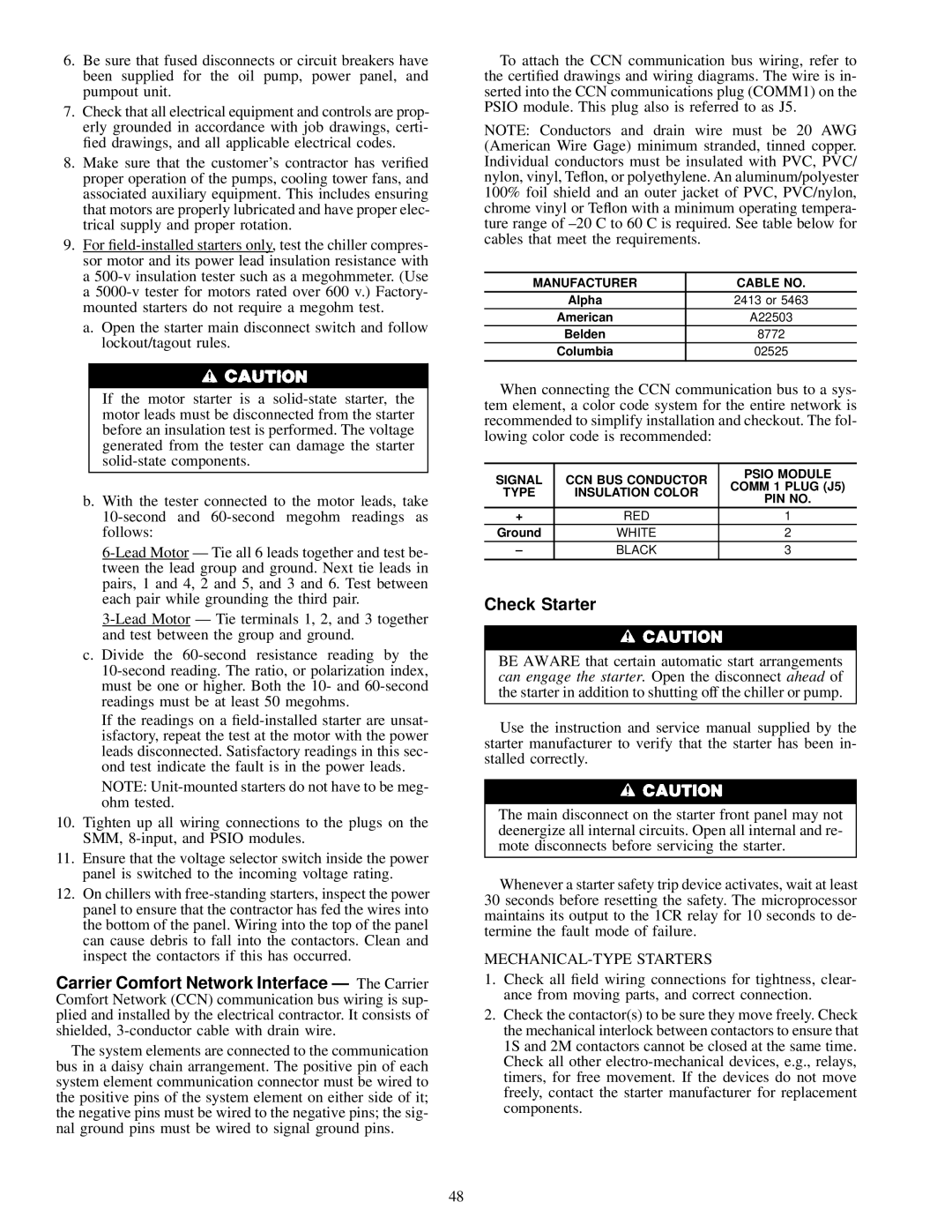6.Be sure that fused disconnects or circuit breakers have been supplied for the oil pump, power panel, and pumpout unit.
7.Check that all electrical equipment and controls are prop- erly grounded in accordance with job drawings, certi- ®ed drawings, and all applicable electrical codes.
8.Make sure that the customer's contractor has veri®ed proper operation of the pumps, cooling tower fans, and associated auxiliary equipment. This includes ensuring that motors are properly lubricated and have proper elec- trical supply and proper rotation.
9.For ®eld-installed starters only, test the chiller compres- sor motor and its power lead insulation resistance with
a500-v insulation tester such as a megohmmeter. (Use
a5000-v tester for motors rated over 600 v.) Factory- mounted starters do not require a megohm test.
a.Open the starter main disconnect switch and follow lockout/tagout rules.
If the motor starter is a solid-state starter, the motor leads must be disconnected from the starter before an insulation test is performed. The voltage generated from the tester can damage the starter solid-state components.
b.With the tester connected to the motor leads, take 10-second and 60-second megohm readings as follows:
6-Lead Motor Ð Tie all 6 leads together and test be- tween the lead group and ground. Next tie leads in pairs, 1 and 4, 2 and 5, and 3 and 6. Test between each pair while grounding the third pair.
3-Lead Motor Ð Tie terminals 1, 2, and 3 together and test between the group and ground.
c.Divide the 60-second resistance reading by the 10-second reading. The ratio, or polarization index, must be one or higher. Both the 10- and 60-second readings must be at least 50 megohms.
If the readings on a ®eld-installed starter are unsat- isfactory, repeat the test at the motor with the power leads disconnected. Satisfactory readings in this sec- ond test indicate the fault is in the power leads.
NOTE: Unit-mounted starters do not have to be meg- ohm tested.
10.Tighten up all wiring connections to the plugs on the SMM, 8-input, and PSIO modules.
11.Ensure that the voltage selector switch inside the power panel is switched to the incoming voltage rating.
12.On chillers with free-standing starters, inspect the power panel to ensure that the contractor has fed the wires into the bottom of the panel. Wiring into the top of the panel can cause debris to fall into the contactors. Clean and inspect the contactors if this has occurred.
Carrier Comfort Network Interface Ð The Carrier Comfort Network (CCN) communication bus wiring is sup- plied and installed by the electrical contractor. It consists of shielded, 3-conductor cable with drain wire.
The system elements are connected to the communication bus in a daisy chain arrangement. The positive pin of each system element communication connector must be wired to the positive pins of the system element on either side of it; the negative pins must be wired to the negative pins; the sig- nal ground pins must be wired to signal ground pins.
To attach the CCN communication bus wiring, refer to the certi®ed drawings and wiring diagrams. The wire is in- serted into the CCN communications plug (COMM1) on the PSIO module. This plug also is referred to as J5.
NOTE: Conductors and drain wire must be 20 AWG (American Wire Gage) minimum stranded, tinned copper. Individual conductors must be insulated with PVC, PVC/ nylon, vinyl, Te¯on, or polyethylene. An aluminum/polyester 100% foil shield and an outer jacket of PVC, PVC/nylon, chrome vinyl or Te¯on with a minimum operating tempera- ture range of ±20 C to 60 C is required. See table below for cables that meet the requirements.
MANUFACTURER | CABLE NO. |
Alpha | 2413 or 5463 |
American | A22503 |
Belden | 8772 |
Columbia | 02525 |
| |
When connecting the CCN communication bus to a sys- tem element, a color code system for the entire network is recommended to simplify installation and checkout. The fol- lowing color code is recommended:
| SIGNAL | CCN BUS CONDUCTOR | PSIO MODULE |
| COMM 1 PLUG (J5) |
| TYPE | INSULATION COLOR |
| PIN NO. |
| | |
| + | RED | 1 |
| Ground | WHITE | 2 |
| ± | BLACK | 3 |
| | | |
Check Starter
BE AWARE that certain automatic start arrangements can engage the starter. Open the disconnect ahead of the starter in addition to shutting off the chiller or pump.
Use the instruction and service manual supplied by the starter manufacturer to verify that the starter has been in- stalled correctly.
The main disconnect on the starter front panel may not deenergize all internal circuits. Open all internal and re- mote disconnects before servicing the starter.
Whenever a starter safety trip device activates, wait at least 30 seconds before resetting the safety. The microprocessor maintains its output to the 1CR relay for 10 seconds to de- termine the fault mode of failure.
MECHANICAL-TYPE STARTERS
1.Check all ®eld wiring connections for tightness, clear- ance from moving parts, and correct connection.
2.Check the contactor(s) to be sure they move freely. Check the mechanical interlock between contactors to ensure that 1S and 2M contactors cannot be closed at the same time. Check all other electro-mechanical devices, e.g., relays, timers, for free movement. If the devices do not move freely, contact the starter manufacturer for replacement components.

